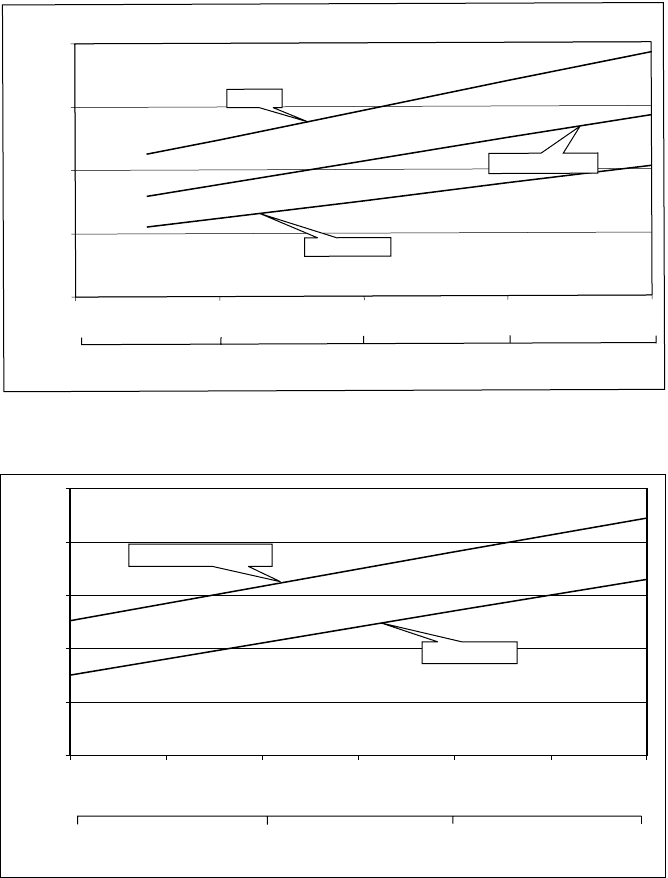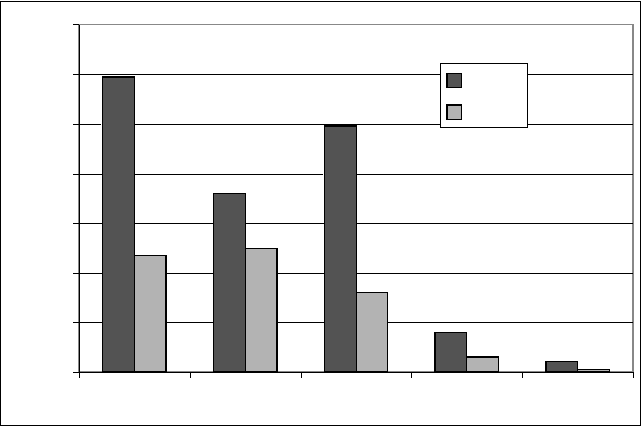Higman Chris Gasification (Газификация угля)
Подождите немного. Документ загружается.


330
Gasification
of the major industrial countries, then a fall in the residue price could make addi-
tional capacity of this sort more attractive.”
Synfuels
The economics of gas-to-liquids (GTL) projects is dependant on both a cheap source
of natural gas and the capital investment. The main incentive for such projects is to
provide a means of bringing gas from remote or other locations where it has little
value to the world energy market. For long-term contracts at such locations, natural
gas prices of around U.S.$0.70/GJ are achievable—a very different situation from
gas prices in Western Europe or North America.
The investment costs for GTL projects have dropped dramatically since the first-
generation (Bintulu, Mossel Bay) projects with the introduction of “second-generation”
technologies. Published data indicate specific capital expenditure of U.S.$20,000–
30,000 per installed bpd of liquid product capacity. Clearly, for a remote location,
the cost development of a local infrastructure will be a major uncertainty in such
numbers and will be highly project-specific.
Table 9-1
Cost of Ammonia Production with Different Feedstocks
Feedstock
Natural
Gas
Vaccum
Residue Coal
Process Steam
reforming
Gasification Gasification
Feedstock price, $/MMBTU 2.8 1.8 1.5
Total energy consumption,
MMBTU/t NH
3
27.0 36.0 45.5
LSTK for plant, 10
6
$ 180 270 400
Total capital*, 10
6
$ 250 350 500
Feedstock and energy costs, $/t NH
3
75.60 64.80 68.25
Utilities, $/t NH
3
3.78 3.24 3.41
Maintenance, $/t NH
3
7.51 11.26 16.68
Personnel, $/t NH
3
6.67 8.34 12.51
Overheads, $/t NH
3
12.22 17.25 25.65
Financing costs**, $/t NH
3
71.74 100.43 143.48
Total costs, $/t NH
3
177.52 205.32 269.99
* Total capital (1998) includes lump-sum turn-key price for plant and storage, spare parts,
catalysts, clients, in-house costs, offsites, working capital (3-months).
** Assumed debt/equity ratio 60:40; depreciation 6%, 8% interest on debts, 16% ROI on
equity.

Economics, Environmental, and Safety Issues
331
Taking this data for a 50,000 bpd project and a conversion efficiency of 8.5 GJ/bbl,
production costs work out at about U.S.$23/bbl of refined product at the remote
location. Given the premium quality of the product, this is a figure that can justify
such projects at current oil prices, but the margins will not be spectacular. On the other
0
100
200
300
400
0
1
23
4
Ener
gy price (Natural Gas and Coal) [US$/MMBTU]
Ammonia production cost [US$/t]
Heavy Residue price [US$/t]
0
40
120
80
160
Natural gas
Heavy residue
Coal
Figure 9-1.
Figure 9-1. Figure 9-1.
Figure 9-1. Production Cost of Ammonia from Different Feedstocks
0
50
100
150
200
250
0.00 0.50 1.00 1.50 2.00 2.50
3.00
Natural gas price [US$/GJ]
Methanol production cost [US$/t]
Heavy Residue price [US$/t]
0
40
120
80
Natural gas
Heavy residue
Figure 9-2.
Figure 9-2. Figure 9-2.
Figure 9-2. Production Cost of Methanol from Different Feedstocks

332
Gasification
hand, the existence of such plants and the experience gained with them would be
a rewarding investment should oil prices rise significantly.
Power Production. As with chemical applications, the economics of power production
using gasification technology is dependant on the clean utilization of cheap feed-
stocks. In many parts of the world the power industry is experiencing a period of
change, brought about by privatization and deregulation, which does not make
decision making easy. In a recent study conducted for the U.K. Department of Trade
and Industry, it was found that even the cheapest technology, natural gas combined
cycle (NGCC), is not viable at current U.K. electricity prices of around 0.02 £/kWh
(~0.03 $/kWh) (Ricketts et al. 2002). However, such a situation cannot be expected
to continue over a longer period of time, so there is considerable value to reviewing
the factors, which can make gasification a competitive option. It must, however, be
appreciated that there are two or even three markets that need to be considered sepa-
rately. In the market for large utility plants, only coal and refinery residues can
provide the feed volumes required. Biomass and waste are fuels that, for reasons
connected with the logistics of the fuel supply, can only support small units (say <50
MW). At this scale, the cost of electricity production is higher than for utility-size
plants; such projects can, however, attract financial support on the basis of environmen-
tal benefits or in the case of waste by charging a gate fee. The third market where gasi-
fication is showing promise is co-firing syngas from a biomass gasifier in a utility-scale
plant, thus securing the benefit of scale without overloading the fuel supply logistics.
Figure 9-3 shows a typical investment cost breakdown for a coal-based IGCC. The
most striking aspect of such a presentation is the approximately equal investment
required for syngas production (ASU, AGR, and gasification) and for the conversion of
the syngas into electricity. In a direct comparison with NGCC, this fact practically
doubles the investment.
Typical investment costs for different types of new power plants have been sum-
marized in Table 9-2.
ASU
12%
Balance of
Plant
7%
CCU
45%
AGR
15%
Gasification
21%
Figure 9-3.
Figure 9-3. Figure 9-3.
Figure 9-3. Capital Cost Breakdown for Coal-Fed IGCC (Source: Adapted from
O’Keefe, et al. 2001)

Economics, Environmental, and Safety Issues
333
These figures do not take any account of environmental performance, and the
typical efficiencies do not reflect the maximum achieved by current IGCCs such as
Buggenum (41.4%, HHV basis). The data does show, however, that with the expectation
of increasing legislative pressure to reduce mercury emissions or capture CO
2
,
IGCC is better placed to respond than combustion technologies. These possibilities
have been discussed in Section 7.3.
Availability and Reliability. As discussed, gasification is a capital-intensive process
that provides a means of utilizing cheap and sometimes unpleasant feedstocks. It is
therefore vital to the successful economics of a plant to ensure that it is operating at
a high rate of utilization. This quickly becomes obvious when studying the figures in
the examples above. An analysis will show that 1% higher availability (i.e., three
days less per year off stream) is worth almost 3% increase in efficiency. It is also
worth about 30% more than a 1% lower investment cost. These are facts of life for
any capital-intensive production facility, and a consciousness of this is important at
every level of decision making.
Gasification has not always had good press when it comes to issues of reliabil-
ity. This is partly because still today, almost all plants are one-of-a-kind units
that do not incorporate the benefits of standardization, and partly because the
performance of demonstration plants has been more widely publicized than that
of commercial operations. The technology is, however, also demanding in terms
of operation and maintenance (O & M) know-how and understanding, and a fail-
ure to recognize this at the inception of a project is a mistake that can be very
costly in terms of downtime. On the other hand, there are many plants in different
Table 9-2
Comparative Costs for New Utility Scale Power Plant
Technology MW
BTU/
kWh % $/kW
NGCC (F turbine) 239 7359 46.4 687
NGCC (G turbine) 323 6743 50.6 524
NGCC (H turbine) 335 6396 53.3 461
Subcritical PC boiler 398 9077 37.6 1129
Supercritical PC boiler 402 8568 39.8 1173
Ultra-supercritical PC
Boiler 400 8251 41.4 1170
IGCC, oxygen blown 543 8522 40.0 1241
PFBC 425 8354 40.8 1190
Source: Lewandowski and Gray 2001
334
Gasification
parts of the world that demonstrate that with the correct procedures in place,
gasification can provide a reliability performance every bit as good as alternative
technologies.
When discussing matters of reliability and availability, it is important to ensure that
one is starting with comparable data. To assist in ensuring a common understanding,
the Gasification Technologies Council has published a set of Guidelines for Reporting
Operating Statistics for Gasification Facilities, based on the concepts of planned and
unplanned outage and on-stream time. These guidelines are reproduced in Appendix D.
Data on commercial operation is limited, but Higman has reported on the operation
of a number of liquid-feed plants (1994), including an example with a 98% on-
stream factor. In another paper he reports on three Indian plants producing 110–123%
of their annualized nameplate capacity (1998). Trapp (2001) reports an on-stream
time of 97.8% for a coal-fed plant.
It should be recognized, however, that there is considerable difference in the
performance of individual components depending on the feedstock. For resid
burners, for instance, an inspection is required every 4000 hours with an antici-
pated repair interval of 8000–12000 hours. Compare this with the 2200 hour life
reported for a coal-feed injector (Trapp 2001). Although this difference is largely
related to the difference in the abrasion characteristics of the feed, there are some
indications that flashing of the water from a slurry-feed exacerbates this situation
(U.S. Department of Energy 2002, p. 25).
Similarly, the very different ash in resids and coals (both quantity and quality)
has an important effect on refractory life. Refractories in resid service require
minor repairs at 16,000-hour intervals with a full replacement on a 20,000–40,000
hour cycle (Higman 1994), whereas in coal service uncooled “refractory liners
are reported to last on the order of 6–18 months” (U.S. Department of Energy
2002, p. 26).
Given this background, it is essential for the success of any gasification project
to recognize all the relevant factors and build them into the design and O & M
strategies from the beginning. It is not possible in a book of this nature to develop
a universal algorithm to finding the appropriate strategy for any future project. It is
important, however, to give an idea of successful strategies and the philosophies
behind them.
Number of Trains
. For very large plants, there may be a minimum number of
trains dictated by the capacity of the largest available reactors. With the steady increase
in unit capacities that has been visible over the last 20 years, this is only likely to be
a major issue for IGCC applications.
A second consideration is the behavior of the overall plant if one reactor is out of
operation. If, as is for example in an ammonia plant, there are a considerable number
of centrifugal compressors, then there is an incentive to maintain the overall plant
operation close to or above the surge limit of the compressors. The strength of this
incentive is, however, also dependant on a number of factors. With resid feed only
the downtime due to burner changes needs to be planned in. This is usually a short
operation, say 8 to 12 hours if the reactor reheat is considered, so the production and
Economics, Environmental, and Safety Issues
335
energy loss is relatively small in a two-reactor configuration, especially if they are
configured as two 60%–capacity units.
In a coal feed but otherwise similar situation, where the reactor is also refractory
lined, one would possibly need to consider relining a reactor in between major turn-
arounds. This is an activity that can last as long as three weeks (again, including
time for cooling down and reheating the reactor). This is intolerable, both because
of loss of production as well as energy efficiency in a two reactor line-up. As a
minimum, a spare offline reactor shell is required, which can be available and
already lined prior to taking the operating reactor off stream. One can then simply
swap the two reactors in the lined condition and restart, saving a considerable length
of downtime. The lining repair can then be performed offline. We know of one plant
that took this philosophy one step further and executed the drying out and part of the
refractory preheating offline and swapped the (admittedly, relatively small) reactors
hot, thus saving even more downtime. The implementation of such a strategy
(whether the reactor swap takes place hot or cold) is, however, dependant on the
layout and detail design of the facility, which must include access and other features
to permit the quick removal of a reactor.
Spare Trains
. In smaller plants, a strategy like the one outlined above may not be
so appropriate. The saving in having two 50% or 60% versus two 100% capacity
reactors decreases substantially with decreasing reactor size. Isolation of a reactor
can only take place between relatively cold locations where valves can be used. This
implies that, for example, a reactor including its syngas cooler has to be taken into
account. Under such a situation, one can develop an operating strategy of keeping
the spare reactor on hot standby and starting it prior to any planned refractory or
feed injector repairs. This is the strategy employed by Eastman and is a key to their
excellent reliability (Hrivnak 2001).
Operation and Maintenance
. An additional key to achieving a high availability
with a gasification plant is a high level of attention to detail in O & M activities
(Hrivnak 2001).
9.2 ENVIRONMENTAL ISSUES
It is difficult to write much about the environment without risking becoming
involved in political arguments. Although we have made no attempt anywhere in
this book to disguise our views on energy policy matters, it is not our purpose here
to propagate such views. This book is being written to convey the basic facts
about gasification so that readers may develop their own ideas from the facts or
use them in the shaping of a gasification project, should they already be involved
in one.
Every country and many provinces or states have their own environmental regula-
tions, so no general guidelines can be formulated that have universal application in
detail. Important trends can, however, be observed from various countries, and
reference will be made to these in the course of this section. Most environmental

336
Gasification
legislation can be grouped by the phase from which the pollutants have to be
removed—gaseous, liquid, or solid. This section on the environmental impact of
a gasification project will be grouped along the same lines.
9.2.1 Gaseous Effluents
The principal gaseous effluents arising from the use of fossil fuels are oxides of
sulfur and nitrogen and particulate matter. Others that require attention are not fully
combusted components, such as carbon monoxide.
Currently in gasification systems the first three components are all removed in
the intermediate fuel gas, where sulfur and nitrogen are present as reduced species
and in higher concentrations than would be the case in flue gas. Both features
make removal of these species to low levels easier. In a comparison with ultra-
supercritical PC technology using SCR and wet FGD, O’Keefe and Sturm 2002
shows that an IGCC power plant can achieve significantly lower emissions than
the PC unit (Figure 9-4). In fact, his figures do not disclose the potential in the
IGCC for further reductions should it be required, as is discussed under the specific
pollutants below.
The U.S. air pollution regulations are at the time of this writing in a state of flux
while the Clear Skies Initiative is being debated. Under the proposals made in the
draft legislation, a coal-gasification–based IGCC would clearly fall under the same
0.00
0.20
0.40
0.60
0.80
1.00
1.20
1.40
SO
x
NO
x
CO PM VOC
Pollutant
Emission [lb/MWh]
PC
IGCC
Figure 9-4.
Figure 9-4.Figure 9-4.
Figure 9-4. Comparison of Emissions from IGCC and PC Power Plants (Source:
O’ Keefe and Sturm 2002)

Economics, Environmental, and Safety Issues
337
regulations as for any other coal-based technology, a situation that, at least as far as
NO
x
is concerned, is currently the subject of different legal interpretations. The
national limits proposed are contained in Table 9-3.
German legislative limits for large liquid-feed power plants, which are largely
drawn from European legislation, are shown in Table 9-4 with the comparison of values
achievable from a residual-oil–based IGCC.
Sulphur emissions. Sulfur compounds have historically received the most attention
when it comes to environmental impact because they are the major cause of acid
rain. The fact that it is so much easier to remove sulfur as H
2
S from high-pressure
fuel gas than as SO
2
from the flue gas has been an important factor motivating the
development of gasification-based power stations and the IGCC concept.
When serious interest in IGCC developed around 1980, it was already possible to
remove 99% of the sulphur in an IGCC based power plant. In fact, the technology
for sulphur removal at orders of magnitude lower than this had already been operat-
ing reliably in commercial situations for many years, whether downstream of coal
gasifiers (e.g. Sasol) or of oil gasifiers (in e.g. ammonia plants). In comparison,
Table 9-3
Emissions Limits in U.S. Clear Skies Initiative
Pollutant Emission limit
Sulfur dioxide 2.0 lb/MWh
Nitrogen oxides 1.0 lb/MWh
Particulate matter 0.20 lb/MWh
Mercury 0.015 lb/GWh
Table 9-4
Emission Limits and Oil-Based IGCC Performance
Pollutant
Emission
Limits Oil-IGCC Regulation
SO
x
, mg SO
2
/m
3
400 20–40 13. BImSchV
Sulfur recovery, % 85 99.6–99.8 13. BImSchV
NO
x
, mg NO
2
/m
3
150 60–150 Umweltminister
Konferenz 5.4.84
Particulates, mg/m
3
50 <0.5 13. BImSchV
338
Gasification
state-of-the-art sulphur removal in a conventional power station was at this time
only about 85–90%.
This situation has changed somewhat. Now sulphur removal can also be achieved
in conventional power stations with two-stage flue gas scrubbing 98–99%. Dry
processes can result in over 99.5% sulphur removal. Nonetheless it remains true
that desulfurization of fuel gas can be achieved to any level desirable with proven
technology.
For chemical applications such as methanol production, the sulphur levels in the
syngas can be reduced to below 100 ppbv, which translates into some 10–12 ppbv in
the flue gas or less than 0.001 lb SO
2
/MWh. This is two orders of magnitude less
than current expectations, as shown in Figure 9-4. Given today’s regulations, this is
more costly than necessary for power production, however it is an indication that
gasification-based technology is ready to meet the tougher standards of the future.
Nitrogen. An important feature of coal as a fuel is its high organic nitrogen con-
tent of 1–2 wt%. Upon combustion a significant part of this nitrogen is oxidized to
NO
x
, which must be removed from the flue gas in an SCR unit where it is catalyti-
cally reduced with NH
3
to elemental nitrogen.
In gasification, virtually no NO
x
is formed, but the organic fuel nitrogen is partially
converted into HCN and NH
3
. These components are removed in a water wash or—
in the case of HCN—by catalytic conversion to NH
3
together with the COS. The gas
combusted in the gas turbine is therefore essentially free of any nitrogen compounds
except molecular nitrogen. NO
x
from the gas turbine is therefore limited to thermal
NO
x
. Current burner designs are capable of values as low as 15 ppmv NO
x
when
firing syngas (Jones and Shilling 2002). Individual units are reported as having
single-figure NO
x
emissions (Hannemann etal. 2002). Should lower values be required,
then it would be necessary to add an SCR, but at present such a demand would
appear illogical, since the IGCC without the SCR can already achieve better results
than any other coal-fired technology. Only firing with natural gas can achieve better
values (9 ppmv). Flue gas recycle and or wet compression offer potential to reduce
the thermal NO
x
even further.
Mercury. Mercury is an element that is present in coals in very differing amounts
and is difficult to remove. The risk to engineering materials and downstream plant
equipment is described in Section 6.9.9.
Mercury emissions to the atmosphere, particularly from conventional coal-fired
power plants, are causing increasing concern, and it will in the near future be subject
to emissions regulations in the United States.
One of the difficulties with mercury capture from flue gas streams is the uncertainty
about the distribution of the various species. In addition to elemental mercury vapor,
it can exist in flue gas as an oxide, chloride, sulfide, or sulfate, the proportions
depending on the levels of other contaminants in the coal. Thus not every mercury
capture technology is suitable for every fuel.
Economics, Environmental, and Safety Issues
339
The IGCC concept has a natural advantage over conventional combustion tech-
nologies in the removal of mercury. Removal to over 90% from synthesis gas has
been demonstrated at Eastman Chemical Company’s coal-to-chemicals facility in
Kingsport, Tennessee, since 1983 using technology developed and used as standard
for natural gas applications (Trapp 2001). In fact, only difficulties with measure-
ment in the ppb range have prevented a determination whether even higher removal
efficiencies are achieved or not. Certainly no product contamination has ever been
detected. Against this is the continued recognition that “no single technology has been
proven that can uniformly control mercury from power plant flue gas emissions in
a cost-effective manner” (U.S. Department of Energy 2003). In a recent investiga-
tion into the costs of mercury removal from flue gas, EPRI estimated the costs of
90% sulfur removal at U.S.$2.80 to $3.30 per MWh (Chang 2001). Rutkowski,
Klett, and Maxwell (2002) have compared this with the application of sulfur-
impregnated activated carbon beds, as in the Eastman plant to a 250 MW
e
IGCC
configuration. The resulting cost obtained was U.S.$0.254 per MWh.
An additional aspect to consider is the clear destination of the mercury on
removal from syngas with activated carbon whereas research is still in progress to
determine the fate of mercury removed from flue gas by various techniques. In
conventional coal-fired power stations equipped with flue gas scrubbing, there is
concern that mercury may end up in the gypsum wallboard, Portland cement, or
manufactured aggregates that are produced. This issue is being addressed in leach-
ability studies on a broad range of solid by-products and wastes (Schwalb, Withum,
and Statnick 2002). Final clarity on this issue is unlikely, however, until commercial
introduction of mercury capture.
Arsenic. Arsenic is currently not regulated as an emission, although there is increas-
ing concern about it. Arsenic is only present in coals and mainly in those coals that
have a high pyrite content. Under reducing conditions, compounds of these elements
are volatile and are entrained in the gas of slagging gasifiers. When fuel gas treating
is applied, compounds of these elements will eventually gather in the water treatment
plant and end up in the settler/filter cake of the flocculation section that has to be
considered as chemical waste. Alternatively, where raw gas shift is applied, it will deposit
on the catalyst. In the case of flue gas treating, the nonvolatile As
2
O
3
will deposit in
any filter or end up in the gypsum.
9.2.2 Greenhouse Gases
The immediate and apparent effects that sulfur and particulate matter have on human
health and SO
x
and NO
x
have on the world around us (forests dying from acid rain),
have provided a strong motivation for the substantial progress that has been made in
reducing these emissions from both the power and the transport sectors. In contrast,
the potential damage of CO
2
emissions is a long-term issue for which the mechanisms
are not fully understood, and this has led to the fact that no clear strategy has
